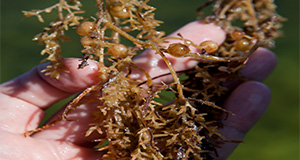Abstract
This publication reviews the importance of seagrass, major threats to seagrass, and ways in which seagrass species diversity and genetic diversity can positively impact seagrass management and restoration. Written by C. Spengler, Jamila Roth, and Laura K. Reynolds, and published by the UF/IFAS Department of Soil, Water, and Ecosystem Sciences, March 2024.
References
Dawson, S. P., and W. C. Dennison. 1996. “Effects of Ultraviolet and Photosynthetically Active Radiation on Five Seagrass Species.” Marine Biology 125:629–638. https://doi.org/10.1007/BF00349244
Flindt, M. R., M. A. Pardal, A. I. Lillebo, I. Martins, and J. C. Marques. 1999. “Nutrient Cycling and Plant Dynamics in Estuaries: A Brief Review.” Acta Oecologica 20 (4): 237–248. https://doi.org/10.1016/S1146-609X(99)00142-3
Fourqurean, J. W., C. M. Duarte, H. Kennedy, N. Marba, N. Holmer, M. A. Mateo, E. T. Apostolaki, G. A. Kendrick, D. Krause-Jensen, K. J. McGlathery, and O. Serrano. 2012. “Seagrass Ecosystems as a Globally Significant Carbon Stock.” Nature Geoscience 5:505–509. https://doi.org/10.1038/NGEO1477
Hazen and Sawyer Environmental Engineers and Scientists. 2008. “Indian River Lagoon Economic Assessment and Analysis Update.” Final Report to IRL National Estuary Program (Contract 24706), Palm Bay, Florida.
Heck, K. L. Jr., F. J. Fodrie, S. Madsen, C. J. Maillie, and D. A. Byron. 2015. “Seagrass Consumption by Native and a Tropically Associated Fish Species: Potential Impacts of the Tropicalization of the Northern Gulf of Mexico.” Marine Ecology Progress Series 520:165–173. https://doi.org/10.3354/meps11104
Hughes, A. R., and J. J. Stachowicz. 2004. “Genetic diversity enhances the resistance of a seagrass ecosystem to disturbance.” Proceedings of the National Academy of Sciences 101 (24): 8998–9002. https://doi.org/10.1073/pnas.0402642101
Hughes, A. R., and J. J. Stachowicz. 2011. “Seagrass genotypic diversity increases disturbance response via complementarity and dominance.” Journal of Ecology 99 (2): 445–453. https://doi.org/10.1111/j.1365-2745.2010.01767.x
Marsh Jr., J. A., W. C. Dennison, and R. S. Alberte. 1986. “Effects of Temperature on Photosynthesis and Respiration in Eelgrass (Zostera marina L.).” Journal of Experimental Marine Biology and Ecology 101 (3): 257–267. https://doi.org/10.1016/0022-0981(86)90267-4
Moncreiff, C. A., M. J. Sullivan, and A. E. Daehnick. 1992. “Primary Production Dynamics in Seagrass Beds of Mississippi Sound: The Contributions of Seagrass, Epiphytic Algae, Sand Microflora, and Phytoplankton.” Marine Ecology Progress Series 87:161–171.
Reynolds, L. K., K. J. McGlathery, and M. Waycott. 2012. “Genetic diversity enhances restoration success by augmenting ecosystem services.” PLOS ONE 7 (6): e38397. https://doi.org/10.1371/journal.pone.0038397
Reynolds, L. K., M. Waycott, and K. J. McGlathery. 2013. “Restoration recovers population structure and landscape genetic connectivity in a dispersal‐limited ecosystem.” Journal of Ecology 101 (5): 1288–1297. https://doi.org/10.1111/1365-2745.12116
Reynolds, L. K., K. DuBois, J. M. Abbott, S. L. Williams, and J. J. Stachowicz. 2016. “Response of a habitat-forming marine plant to a simulated warming event is delayed, genotype specific, and varies with phenology.” PLOS ONE 11 (6): e0154532. https://doi.org/10.1371/journal.pone.0154532
Reynolds, L. K., K. A. Tiling, G. B. Digiantonio, V. G. Encomio, and L. J. Morris. 2019. “Genetic diversity of Halodule wrightii is resistant to large scale dieback: A case study from the Indian River Lagoon.” Conservation Genetics 20:1239–1337. https://doi.org/10.1007/s10592-019-01214-z
Waycott, M., C. M. Duarte, T. J. B. Carruthers, and S. L. Williams. 2009. “Accelerating loss of seagrasses across the globe threatens coastal ecosystems.” Proceedings of the National Academy of Sciences 106 (30): 12377–12381. https://doi.org/10.1073/pnas.0905620106
Williams, S. L. 1990. “Experimental Studies of Caribbean Seagrass Bed Development.” Ecological Monographs 60 (4): 449–469.
Williams, S. L., R. Ambo-Rappe, C. Sur, J. M. Abbott, and S. R. Limbong. 2017. “Species richness accelerates marine ecosystem restoration in the Coral Triangle.” Proceedings of the National Academy of Sciences 114 (45): 11986–11991. https://doi.org/10.1073/pnas.1707962114
Yachi, S., and M. Loreau. 1999. “Biodiversity and Ecosystem Productivity in a Fluctuating Environment: The Insurance Hypothesis.” Proceedings of the National Academy of Sciences 96 (4): 1463–1468. https://doi.org/10.1073/pnas.96.4.1463

This work is licensed under a Creative Commons Attribution-NonCommercial-NoDerivatives 4.0 International License.
Copyright (c) 2024 UF/IFAS

